Agra is known as the city of the Taj but the town has its share of heritage beyond the Taj. The left bank of Yamuna river, opposite the Taj, once housed about a dozen Mughal-style gardens complete with pavilions and chhatris. Stretching across the gardens were tree-lined pathways complete with water channels, which in turn were decorated with fountains.
After the first battle of Panipat (1526), Babur established the Mughal rule in India. He was tortured by the hot and dry climate of north India. He missed the swift flowing steams of his homeland. So in order to escape the heat, he constructed several char-bagh (four-quarter) Mughal Gardens in his new capital, Agra. They were similar to the gardens he has seen during his childhood days in Samarkhand. These Mughal Gardens comprised descending terraces with water channels and provided a relief from the surrounding sweltering heat.
William Dalrymple mentions in his book City of Djinns: “Inheriting the Greek love of order and logic, Islamic gardens – like their buildings – are regimented into lines of perfect symmetry…” Today, a handful of these heavenly gardens still stand along with a couple of mausoleums and can be an interesting exploration of Agra beyond the Taj.\
Mehtab Bagh

The view of the Taj Mahal from Mehtab Bagh.
Today, Mehtab Bagh, the moon-lit garden, stands bang opposite the Taj Mahal on the other side of the river. It is in perfect alignment with the Taj complex and is often visited by tourists for a great view of the Taj. Legend also says that this was the place for the black Taj Mahal, which was supposed to house the mortal remains of Shah Jahan. But that was not to be.
Moreover, several historians doubt about the plan of the Black Taj. Also, historical facts state that the Mehtab Bagh predates the Taj and the Taj complex was built in alignment with the Mehtab Bagh. The garden was constructed by Babar. Over the decades and centuries, the garden has gone through several modifications. Today, apart from a few chhatris along with the remains of water channels and reservoirs, nothing much is left of the moon-lit garden. It still draws a large crowd for the amazing view of the Taj towering above the banks of Yamuna.
Gyarah Sidi
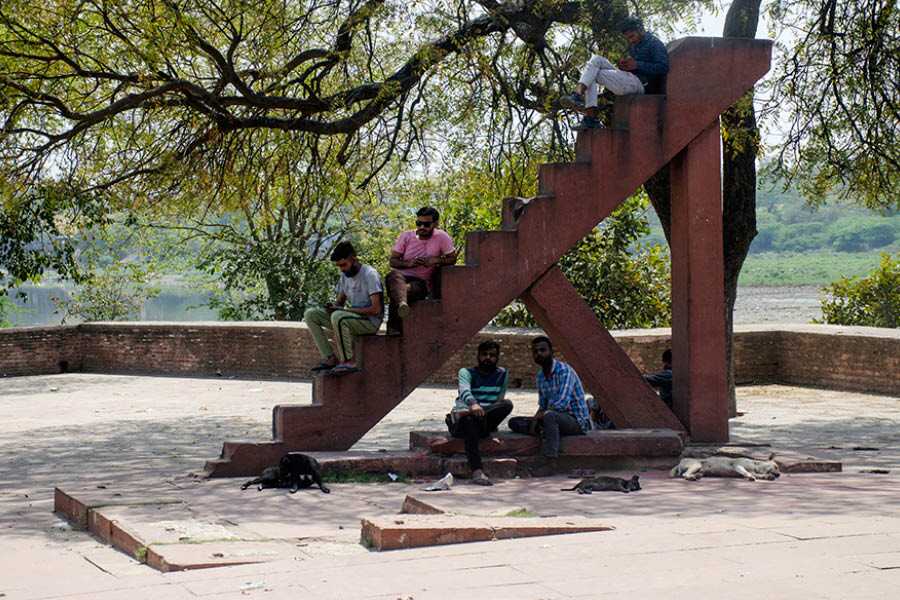
Sadly, nothing much remains of the Mughal era observatory. The 11 steps stairs still stand and so does a few scattered structures.
This strange site is located on the bank of Yamuna and is just north of Mehtab Bagh. A narrow road bifurcates from the main road and leads to the Gyarah Sidi, passing next to a playground with the Taj towering in the backdrop. Gyarah Sidi, literally meaning 11 steps, is an observatory built by Humayun. Humayun was a believer of astrology and had the observatory constructed to keep track of celestial bodies. Sadly, nothing much remains of the Mughal era observatory. The 11 steps stairs still stand and so does a few scattered structures.
Tomb of Itimad-ud-Daulah

Itimud-ud-Daulah and (right) multi-coloured inlay work on the monument.
This amazingly beautiful mausoleum is often referred to as the ‘Baby Taj’, sadly apart from the marble finish, the two structures have hardly any structural similarities. Moreover, the tomb predates the Taj. It was completed a couple of years before the construction of the Taj started. Itimad-ud-Daulah was an important official in the courts of both Akbar and Jahangir. His original name was Mirza Ghiyas Beg. He was awarded with the title ‘Itimad-ud-Daulah’, meaning pillar of the state. But he is more famous in history as the father of Nur Jahan. He died in 1622 and Nur Jahan built the tomb to house his mortal remains.

The tomb was completed in 1628 and also houses the remains of Nur Jahan’s mother. The tomb stands at the centre of a char-bagh styled garden with four massive sand stone gates on four sides. Today, approach is through the eastern gateway and leads to the marble mausoleum The tomb is crowned with a chhatri and the corners houses octagonal minners. The thing that sets the tomb apart is the multi-coloured inlay work complete with semi-precious stones. The intricate inlay work is complimented with the decorative marble screens giving a ‘jewel box’ appearance. Colourful decorations are also found in the interiors of the tomb housing several graves.
Chauburji
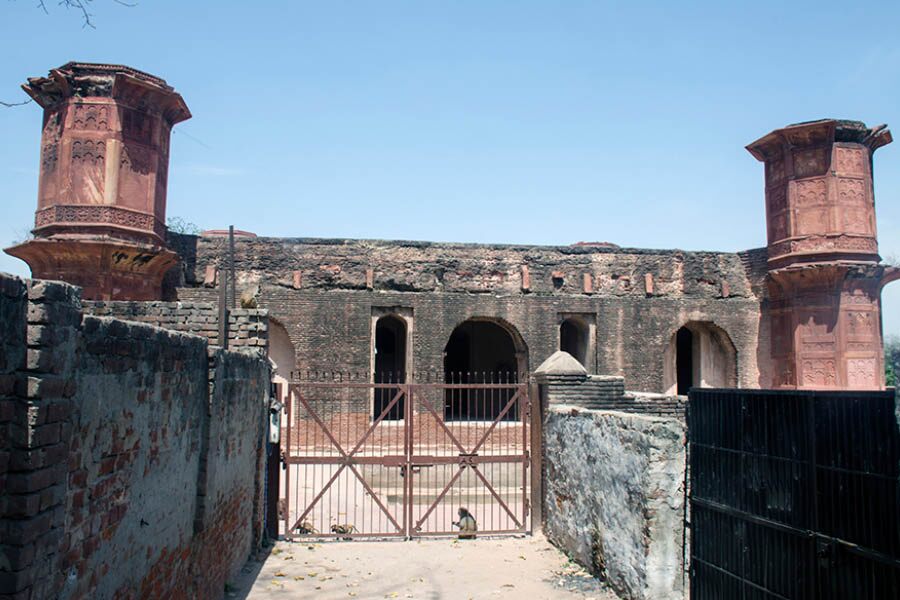
Built of sandstone, this structure once housed the mortal remains of the first Mughal emperor, Babur.
This is just stoneְ’s throw away from the tomb of Itimad-ud-Daulah. It is off the main road and off the tourist map. The structure has a similar plan with its more beautiful neighbour but lacks the marble finish and the ornamentation. Built of sandstone, this structure once housed the mortal remains of the first Mughal emperor, Babur. After his death in 1530, Babur was temporarily buried here and later his mortal remains were shifted to Kabul. Sadly, the tomb lies in utter neglect and is always kept under lock and key.
Chini ka Rauza
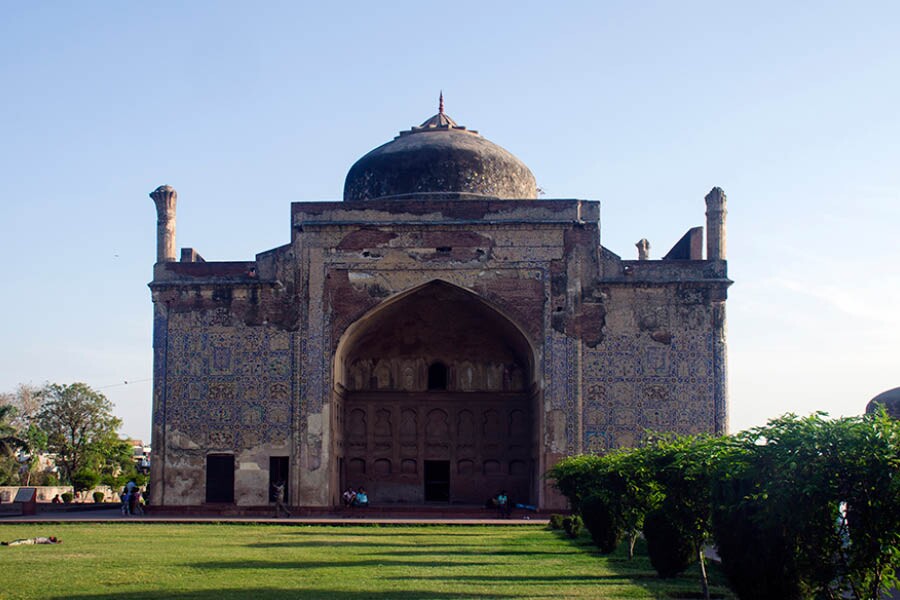
Only traces of the Chinese tiles remain to this day.
This tomb stands north of Itimud-ud Daulah and overlooks the Yamuna. The exterior of the sandstone tomb is decorated with beautiful blue Chinese porcelain and hence the name (chini coming from China). Sadly, only traces of the Chinese tiles remain to this day. The tomb houses the mortal remains of Afzal Khan, an important officer in the courts of both Jahangir and Shah Jahan.
He himself constructed the tomb during his lifetime. He died in Lahore in 1639 and his mortal remains were brought back to Agra. The interior houses two graves complete with richly painted walls. Nothing much remains of the grand complex, which was once housed two towers along with a flight of stairs leading to the Yamuna. One of the towers still stands to this day and so does another tomb locally known as Kala Gumbad (black dome).
Ram Bagh
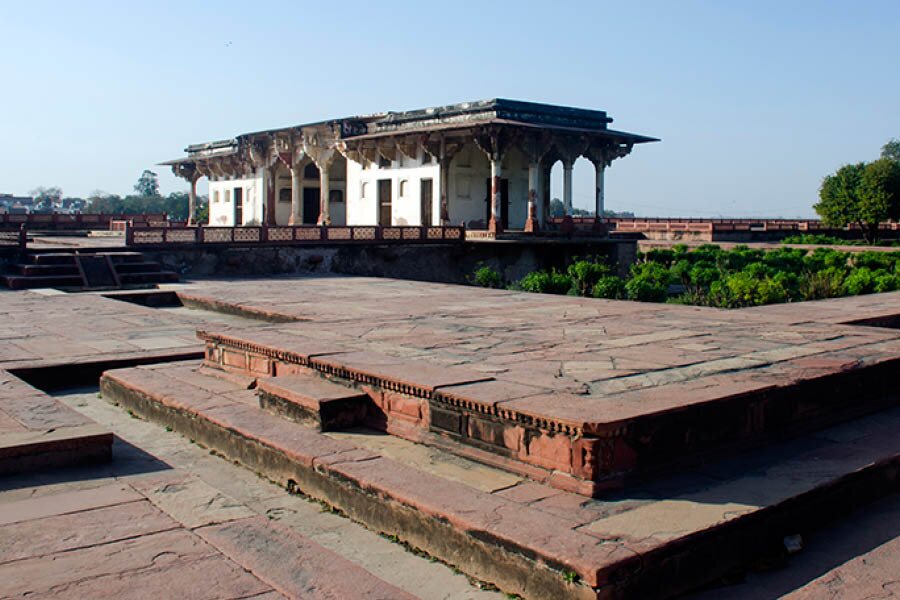
Two of the Jahangir’s pavilion stand and so do a number of ‘chhatris’.
Originally known as Bagh-I-Gul-Afshan (the flower-scattering garden) and Bagh-I-Nur-Afshan (the light-scattering garden). This garden was constructed by Babur in 1526 and happens to be the first Mughal garden of the sub-continent. Over the years, the name changed to Aram Bagh (garden of rest) and then shortened to Ram Bagh. Although built by Babur the garden went through extensive renovation during the reign of Jahangir. Today, two of the Jahangir’s pavilion stand and so do a number of chhatris. The place provides a grand view of the meandering Yamuna along with several other ruined structures along its banks.
A share of nature
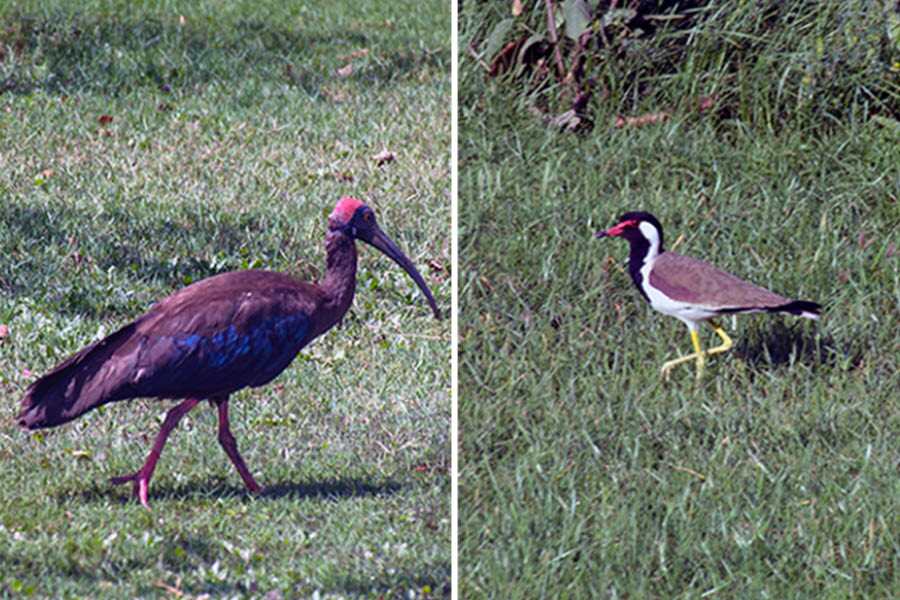
Migratory and residential birds inside the Mughal Gardens in Agra.
Dalrymple further writes, “Outside the garden, all is delightful chaos..” Today, Agra is an unplanned city complete with chaotic traffic and high levels of pollution. The Mughal Gardens not only serve as an oasis of peace but also supports a unique micro ecosystem supporting a variety of wildlife. This include several migratory and residential birds.


